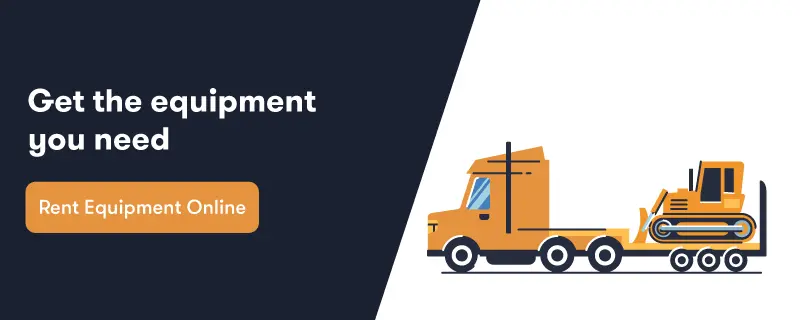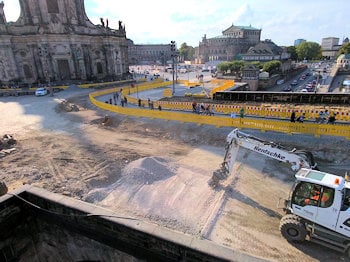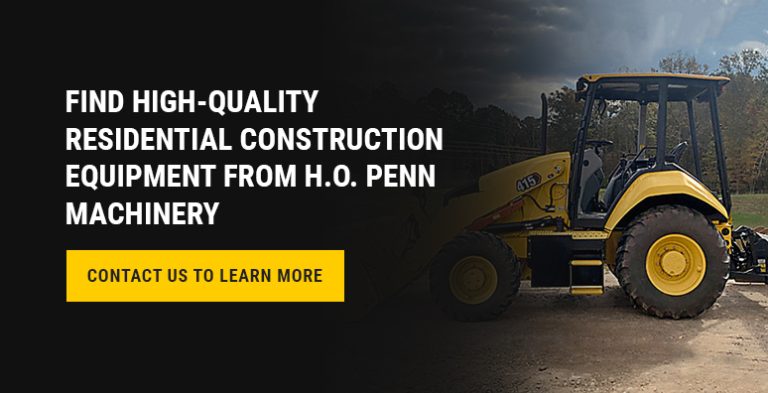Radial Lift vs. Vertical Lift Skid Steer: Which One Should You Choose? | Bigrentz
When looking for the right skid steer loader or compact track loader, you’ll have the option to choose a radial lift or a vertical lift. The difference is the lift arm design and its functionality.
Radial lift machines lift loads on a curved path, while vertical lift machines lift on a vertical path, moving the lift arm straight up and down. Radial lifts have one pivot point while vertical lifts have multiple, making them more complex.
While both radial lifts and vertical lifts can dig and lift materials, each one is best suited for certain situations and applications. In this post, we go over the basics of radial lifts and vertical lifts: their similarities and differences and how to choose the right one for your next job.
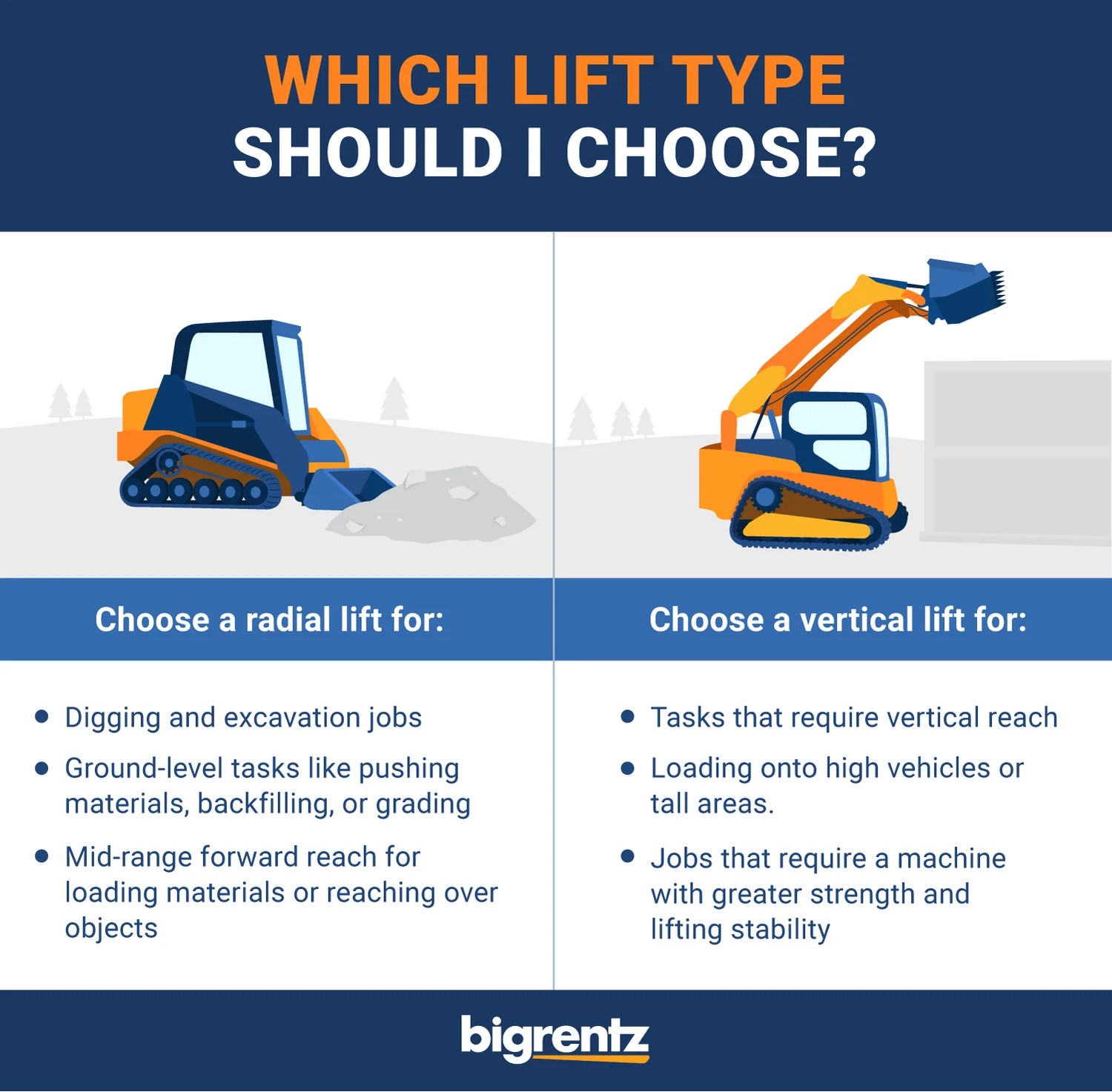
Explore All Skid Steers
Radial Lift Applications
The arm on a radial lift pivots at the rear of the machine. It moves in an arcuate trajectory as it’s raised, meaning it extends both upwards and outwards. With the most reach at mid-range, a radial lift arm is good for tasks that are at or below eye-level, making it a great choice for digging and grading.
Common uses and applications include:
- Digging and excavation: A radial lift can handle digging tasks at significant depths, like trenching and excavating.
- Pushing materials: A radial lift can help clear a job site by removing debris like rocks or stumps, or pushing materials like dirt or snow.
- Loading materials: A radial lift can load and unload materials, like dirt or rocks, onto or off of trucks or platforms.
- Backfilling, grading, and landscaping: A radial lift can backfill excavated areas, grade surfaces, or help in moving landscaping materials.
Radial Lift Attachments
Specialized attachments expand on the capabilities of radial lift machines. Here are some common attachments and their uses.
- General purpose buckets: These attachments help in digging, dozing, and ground-level material handling.
- Grapple buckets or grapple rakes: With more grip than conventional buckets, these attachments are useful for tasks like debris cleanup, brush removal, or handling irregularly shaped objects.
- Trenchers: These attachments help dig trenches at ground level.
- Mulchers or brush cutters: These attachments work to clear overgrown vegetation or in general land clearing at or near ground level.
- Snow blades or snow blowers: These attachments build on a radial lift machine’s built-in pushing strength to make snow removal more effective.
- Landscape rakes or tillers: These attachments help with ground preparation and landscaping tasks.
Vertical Lift Applications
A vertical lift has a more complex linkage system, allowing the lift arm to move nearly straight up and down. This provides more vertical reach than you’d get with a radial lift. Multiple pivot points also provide more versatility than a radial lift’s single pivot. Vertical lifts are best for applications that require a higher reach.
Common uses and applications include:
- Material handling and stacking: Its vertical lift path allows a vertical lift machine to bear and lift loads at significant heights, making it effective in stacking.
- Loading high-sided trucks: Similarly, vertical lift machines can load materials into high-sided trucks like dump trucks or onto elevated platforms without having to move closer to them.
- Drilling tasks: Using an auger attachment, vertical lift vehicles are effective at drilling into materials vertically.
Vertical Lift Attachments
Just like radial lifts, vertical lifts can support specialized attachments, too. Here are some common ones and their applications:
- Material handling arms: For tasks that require lifting, placing, or stacking materials at significant heights, these arms can increase both grip and load capacity.
- Pallet forks: These attachments are specialized for handling pallets, making it easier to stack pallets or move them to elevated locations.
- High-capacity buckets: These buckets can handle heavy or high-volume materials at height, like when you need to load them into high-sided vehicles or containers.
- Man platforms: These platforms are designed to elevate workers for tasks like maintenance, pruning, or painting.
- Augers: As mentioned above, these attachments help with drilling, especially at elevated positions, like installing tall posts or poles.
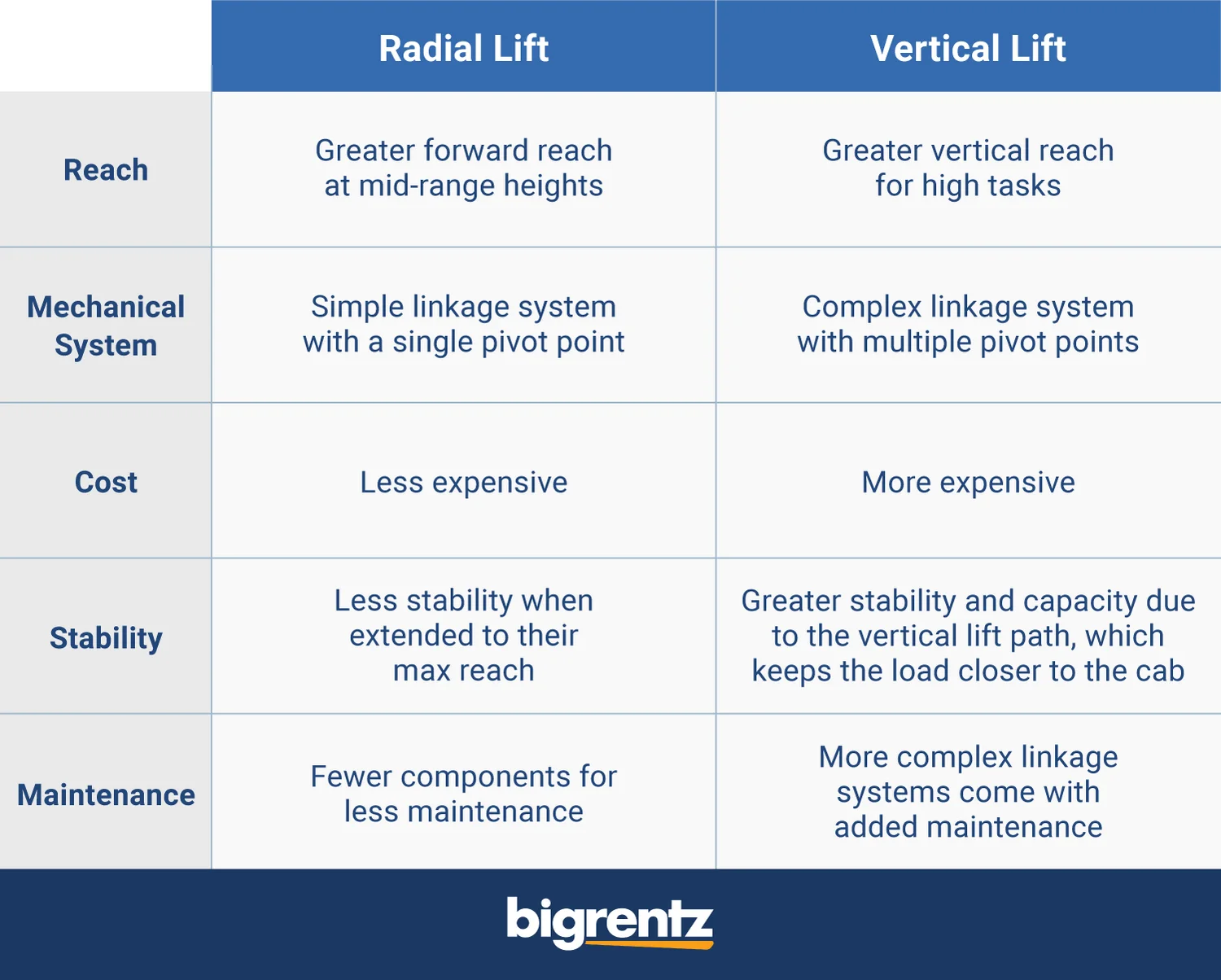
Radial Lift vs. Vertical Lift
Radial lifts and vertical lifts are both effective in material handling, but they have some key differences. To determine which type of machine is best for your job, consider these points of comparison.
Vertical Lifts Have Greater Vertical Reach
Vertical lifts are better for height tasks compared to radial lifts. It’s because of their lift paths—vertical lift arms go nearly straight up and down rather than at a curved trajectory, giving them more reach at full height.
Also, the load remains close to the machine when it goes up and down, keeping it level and stable through the lifting process, so you can safely move or place objects at height.
Radial Lifts Have Greater Forward Reach At Mid-Range Heights
Though they may not be able to go as high, radial lifts have better forward reach than vertical lifts, especially at mid-range heights.
Radial lifts operate on single pivot points, located at the rear of the loader arm. When the arm is lifted, it moves upwards and outwards, giving you more forward reach. For this reason, radial lifts are very stable at mid-level heights.
Vertical Lifts Have a More Complex Mechanical System
Of the two machine types, vertical lifts are more complex. Their linkage system involves multiple pivot points and interconnected bars or rods, all working to accomplish the smooth, stable up and down movement. This makes the machine more stable as a whole, less likely to tip over even when you’re lifting more weight or working at higher elevations.
Radial lifts have just a single pivot point near the rear of the loader arm. It’s a simpler mechanical system, resulting in the curved or upward and outward motion of the lift. But, in use, this can cause a shift in the load’s center of gravity, making the machine less stable overall.
Radial Lifts Are Typically Less Expensive
Since they’re simpler machines, radial lifts typically come with a slightly lower price tag compared to vertical lifts.
However, it’s still important to choose the machine that will work best for your job rather than the one with the lowest cost. Trying to work with a machine that can’t do what you need it to do might be more expensive in the end, in terms of both your time and having to switch equipment.
Vertical Lifts Offer More Stability
Due to their vertical lift path and higher load capacity, vertical lifts offer more stability. This is especially true when you’re working at significant heights.
Though radial lifts are stable at mid-range heights, their lift arms’ forward extension can sometimes upset a load’s center of gravity.
Vertical Lifts Require More Maintenance
Since they have more complex configurations, vertical lifts typically require more maintenance. A vertical lift’s intricate linkage system requires more frequent checks and potential adjustments to keep the machine running smoothly. Also, the complexity of vertical lifts might mean specialized training or expertise is needed for maintenance, which could influence long-term maintenance costs.
On the other hand, the single pivot point design of radial lifts means they have fewer components that can wear out or need replacement. This translates to potentially lower maintenance costs over time.
Radial vs. Vertical Lift Skid Steer Specs
Skid steers are wheel-based machines, making them ideal for hard surfaces like asphalt, concrete, and compacted soil. They perform best on relatively flat terrain and in dry conditions.
Whether you’re looking at a radial lift skid steer or a vertical lift skid steer, there are a few key skid steer specs to keep in mind:
- Operating capacity: This determines how much weight the machine can safely lift or handle. Make sure any skid steer you choose has the operating capacity to handle the weight of your load.
- Tipping load: The tipping load is the amount of weight that could cause the machine to tip—essentially its maximum. Knowing this amount helps prevent you from overloading the machine, avoiding tipovers.
- Lift height: This is the maximum height a loader can lift. Make sure your machine has the lift height your job needs, especially if you’re working at height.
Here’s an overview of skid steer specs for some popular brands and models.
| Brand and Model | Lift Type | Operating Capacity (lb) | Tip Load (lb) | Height to Hinge (in) | Reach Height (in) |
| John Deere 312GR | Radial | 1,550 | 3,100 | 115.1 | 15.8 |
| Bobcat S62 | Radial | 2,100 | 4,200 | 114.5 | 20.4 |
| Case SR270B | Radial | 2,700 | 5,400 | 125.1 | 22.2 |
| John Deere 318G | Vertical | 1,945 | 3,890 | 120 | 34 |
| Bobcat S66 | Vertical | 2,571 | 5,142 | 120 | 34.2 |
| Case SV280 | Vertical | 2,800 | 5,600 | 129.5 | 38.3 |
If you’re looking for a skid steer, here are the average costs to rent one from BigRentz:
- 1500–1699 lb Wheel Skid Steer Loader: $223/day, $665/week, $1,899/month
- 1700–1999 lb Wheel Skid Steer Loader: $218/day, $661/week, $1,665/month
- 2000-2499 lb Wheel Skid Steer Loader: $365/day, $1,096/week, $2,858/month
Radial vs. Vertical Track Loader Specs
A compact track loader is a type of skid steer. Instead of running on wheels, track loaders have continuous tracks that help them work through soft or muddy ground, snowy or wet conditions, and rough or uneven terrain.
Here’s an overview of track loader specs for some popular brands and models.
| Brand and Model | Lift Type | Operating Capacity (lb) | Tip Load at 50% (lb) | Lift Height (in) | Lift Reach (in) |
| John Deere 316GR | Radial | 1,750 | 3,500 | 115.1 | 15.8 |
| Bobcat T630 | Radial | 2,100 | 3,000 | 121 | 24.1 |
| Case TR270B | Radial | 2,700 | 5,400 | 125.1 | 25.6 |
| Bobcat T870 | Vertical | 3,500 | 7,000 | 120 | 36.7 |
| John Deere 333G | Vertical | 3,700 | 5,285 | 132 | 37.8 |
| TV370B | Vertical | 3,700 | 7,400 | 131.1 | 40.5 |
If you’re looking for a track loader, here are the average costs to rent one from BigRentz:
- 1000–1999 lb John Deere Track Skid Steer Loader: $319/day, $896/week, $2,273/month
- 2000–2499 lb Track Skid Steer Loader: $365/day, $1,096/week, $2,858/month
Which Lift Type Should I Choose?
Both radial lifts and vertical lifts can be great assets in various material handling applications. The best skid steer for your job is ultimately going to be the one that suits your specific project needs most.
When to Choose Radial Lift
You might want to choose a radial lift if your project involves tasks like:
- Digging and excavation jobs
- Primarily ground-level tasks
- Mid-range forward reach for loading materials or reaching over objects
When to Choose Vertical Lift
You might want to choose a vertical lift if your projects have the following needs:
- Vertical reach is required
- Loading onto high vehicles or tall areas
- You need a machine with greater strength and lifting stability
::backdrop{background:rgba(0,0,0,.65)}.cta–dialog[open]{border-width:0;display:flex;flex-direction:column;align-items:center;width:90%;max-width:37.5rem;padding:1.5rem}.cta–dialog[open] .dialog–close{position:absolute;top:1.25rem;right:1.5rem;font-size:30px;line-height:1}.cta–dialog[open] .dialog–header{font-size:1.5rem;font-weight:500;line-height:1.3;text-align:center;margin:1.5rem auto .5rem;padding:1.5rem 0 0}@media (min-width: 768px){.cta–dialog[open] .dialog–header{font-size:2rem;margin:0 0 .5rem;padding:0;text-align:left;width:80%}}.cta–dialog[open] .wrapper–form-illo{display:flex;flex-direction:column;align-items:center;width:100%}@media (min-width: 768px){.cta–dialog[open] .wrapper–form-illo{flex-direction:row;justify-content:center;column-gap:2rem}}.cta–dialog[open] svg{margin-top:.5rem;width:52%;max-width:11.5rem}@media (min-width: 768px){.cta–dialog[open] svg{margin-top:0;max-width:15rem}}@media (min-width: 768px){.cta–dialog[open]{align-items:flex-start}}
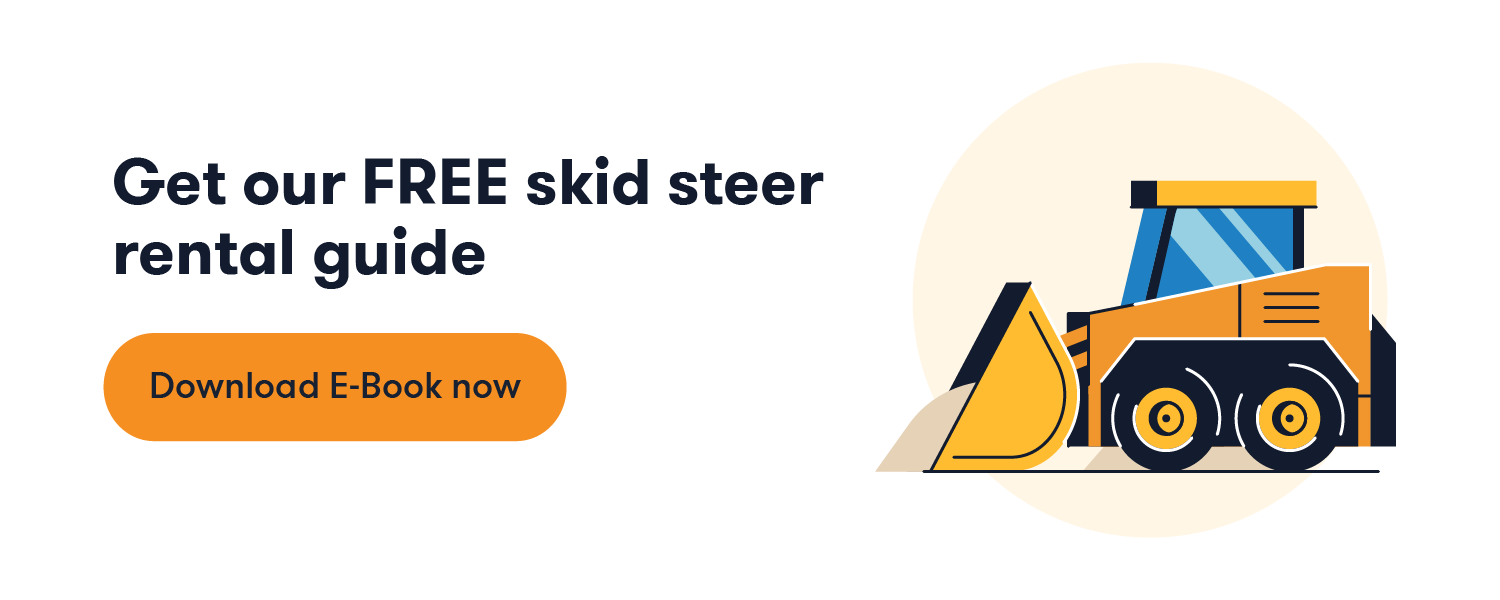
×
Download our FREE skid steer rental guide e-book today!
Explore All Skid Steers
Ready to Rent a Skid Steer or Track Loader?
If you have material handling needs, a skid steer or a track loader might just be the right piece of equipment for you. If you’re working at height, you’ll want a machine with a vertical lift. If you need more forward reach, a radial lift machine might fit the bill better.
For all your equipment needs, BigRentz has you covered. Whether you’re ready to rent a skid steer or a track loader, we’ve got the latest machines to help make any project a success.
